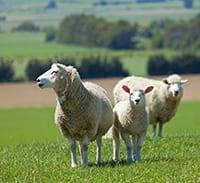Blog
No Patenting Dolly
The Federal Circuit ruled last Thursday that Dolly the Sheep (July 5, 1996 — February 14, 2003), and clones like her, is not patent eligible. In re Roslin Institute (Fed. Cir. May 8, 2014) (DYK, Moore, Wallach).
In re Roslin Institute (Fed. Cir. May 8, 2014) (DYK, Moore, Wallach).
Dolly was the first mammal ever cloned from an adult somatic cell. To create Dolly, the inventors fused the nucleus of an adult, somatic cell with an enucleated (i.e., without a nucleus) oocyte. A nucleus is an organelle that holds the genetic information (DNA) of a cell. Dolly was therefore genetically identical to her adult donor. This "somatic cell nuclear transfer" cloning method was "a breakthrough in scientific discovery." Slip op. at 2.
In affirming the Patent Trial and Appeal Board's rejection of claims 155-159 and 164 of U.S. Application No. 09/225,233, directed to "a live-born clone of a pre-existing, non-embryonic, donor mammal," under § 101, the Federal Circuit appeared to interpret the Supreme Court's § 101 precedent—including Funk Brothers, Chakrabarty, and Myriad—as requiring the subject matter in question to possess "markedly different characteristics from any found in nature" in order to qualify as a "non-naturally occurring organism," regardless of whether it was produced by nature or created in a lab. Id. at 5-7. "Dolly's genetic identity to her donor parent," therefore, "renders her unpatentable." Id. at 7. Although Roslin was not patenting the genetic information itself, the court nonetheless found the case to be analogous to the isolated DNA in Myriad. The court reasoned that "as in Myriad, Roslin 'did not create or alter any of the genetic information' of its claimed clones, '[n]or did [Roslin] create or alter the genetic structure of [the] DNA' used to make its clones." Id. (quoting Myriad, 133 S. Ct. at 2116).
The Federal Circuit also drew support from the Supreme Court's decision in Sears Roebuck & Co. v. Stiffel Co., 376 U.S. 225 (1964), where the Court held that Sears could not be liable for copying a lamp design whose patent protection had expired. Slip op. at 8. According to the Federal Circuit, Sears confirmed that a "copy" of an unpatentable subject matter (in this case, Dolly's donor), however created, must be patent ineligible because anyone is "free to copy any unpatentable article." Id. at 8. (But while a copy of a pre-existing, unprotected lamp design most likely is unpatentable, most would agree that the copied lamp design would be patent eligible under § 101.)
The court was unswayed by Roslin's arguments that the claimed clones were patent eligible because phenotypic differences that resulted from environmental factors and differences in mitochondrial DNA distinguished the clones from their donors. Id. at 9-11. The court dismissed these differences as unclaimed and irrelevant, noting that "[t]here is nothing in the claims, or even in the specification, that suggests that the clones are distinct in any relevant way from the donor animals of which they are copies." Id. at 11. The court also rejected Roslin's argument that the clones were patent eligible because they were time-delayed versions of their donors. Id. The court found the "time-delayed characteristic" insufficient to confer patent eligibility because "it is true of any copy of an original." Id.
The court's decision should come as no surprise. During the oral argument, Judge Moore interrogated counsel for Roslin why Roslin's case was "not frivolous in light of Myriad and the other Supreme Court precedent" and why Roslin did not "just dismiss" its case.
On the bright side, the court stated that "having the same nuclear DNA as the donor mammal may not necessarily result in patent ineligibility in every case." Id. at 11. (It remains to be seen, though, what differences would be deemed "relevant" despite the identity in genetic information.) In addition, Roslin obtained a patent on claims drawn to the somatic transfer method of cloning mammals, which was not before the Federal Circuit in the appeal. Id. at 3. So maybe personalized medicine is not yet all dead, contrary to what some commentators proclaimed after the ruling.
The opinions expressed are those of the authors on the date noted above and do not necessarily reflect the views of Fish & Richardson P.C., any other of its lawyers, its clients, or any of its or their respective affiliates. This post is for general information purposes only and is not intended to be and should not be taken as legal advice. No attorney-client relationship is formed.